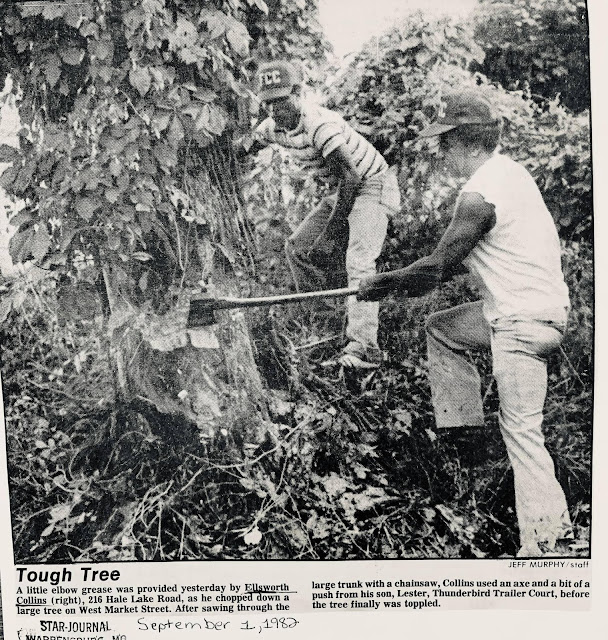1925-1987
StM1c V68 Ellsworth Lester Collins,
866 65 55
Warrensburg, Missouri US Navy
Link to Mt. Olive History https://1973whsreunion.blogspot.com/2017/11/1832-mt-olive-settlement-started-1865_7.html
Selective Service Registration 22 April 1943
Enlistment Date: 17 May 1943
Ellsworth is not in this photo as his Navy photos were consumed in a fire at military records facility.
19 July 1944
1945 B-29 Bomber Ditching & Rescue by USS Bering Strait
1945, RESCUE SQU1945, RESCUE SQUADRON THREE, USS BERING STRAIT ADRON THREE, USS USS Bering Strait, Rescue Squadron Three - Saving American Aviators that had to ditch in the Pacific Ocean.
(2) 1945, VH3, USS BERING STRAIT (AVP-34), USS CHANDELEUR (AV-10), KERAMA RETTO, MARTIN MARINER - YouTube - Ditching and rescue of Hopeful Devil aircraft by USS Bering Strait
We chose to leave the entire 12 min raw footage uncut. Following our request, Mr. McCaskill was so kind to write the story behind this "never seen before" footage, giving us all the particulars about this forgotten episode of WW2.
Here are Mr. McCaskill's notes:
"(cut) ...During the ditching my father's back was broken and he was evacuated back to the US for convalescence. During his long stay in a military hospital, he met the cameraman who had filmed the rescue. It was a chance meeting. The cameraman gave him two unedited copies of the 16mm film, each in a metal can. We never had a 16mm projector, so these film canisters lay undisturbed in my father's closet for over 50 years."
THE HISTORY BEHIND THE VIDEO...
On March 9, 1945 over 300 B-29 bombers took off from airfields on the islands of Tinian, Saipan, and Guam and headed for Japan. Their mission was to bomb the port and urban areas of Tokyo.
To complete the mission, the crews had to fly 1,500 miles to get to Japan, make their bombing runs, and then fly the 1,500 miles back to their home base--fifteen stressful hours of flying over water.
In order to increase bomb capacity, fuel loads were kept to a minimum. Consequently, planes damaged in combat, suffering from mechanical malfunctions, or thrown off course often could not make it back to base.
Many were lost without leaving a trace; some were seen to crash after crewmen had bailed out, and others were deliberately put down at sea, in a procedure known to airmen as "ditching."
The B-29 seen ditching here is the "Hopefull-Devil" under the command of Captain Bernard "Barney" McCaskill Jr. Aircrew 84-02, 484th Squadron, 505th Bombardment Group, 313th Bombardment Wing.
Realizing they did not have enough fuel to reach the home base on Tinian Island, the "Hopefull-Devil" radioed a call for help.
The distress call was picked up by the seaplane tender USS Bering Strait (AVP-34) on lifeguard duty approximately 20 miles north of Pagan Island. The ship vectored the "Hopefull-Devil" to its position and Captain McCaskill ditched alongside at 12:38PM on March 10, 1945.
Ocean swells at the time were about 6 feet (2 meters) making a smooth ditching impossible. Per their training, all crew members, except for the pilots, were at ditching stations with their backs against a bulkhead of some kind. As you can see, the force of the impact was tremendous. The plane went from 100mph to zero in less than a plane length.
In a newspaper article reporting on the incident Capt. McCaskill explains what happened while the USS Bering Strait (AVP-34) launched its whaleboat to pick up the crewmen in the water:
"I was pushing down on the rudder pedals for the landing, and that and handling the wheel made my body pretty stiff for the impact. That's why my back got broken.
"I couldn't stand up afterwards and I looked up and the co-pilot [Col. Macomber who was along for a guest rid]) was already getting out. The water started rushing in about then. It washed me back to my seat."
But Capt. McCaskill managed to grab hold of the window and pull himself outside. "I had a canteen on my belt. It was knocked off. I was jerking so hard to get myself out."
Outside Capt. McCaskill said he counted heads and saw all were there. But he found that the two gunners back at the tail were having a 'rough time'. They couldn't swim. Capt. McCaskill inflated the Mae West of one of the boys so he was all right. The other [Corporal Rivas] was holding on to the plane and was being slapped back into the water each time the plane was caught by a wave.
"I told him to turn loose the airplane. He didn't want to but did. It was at the wrong moment, though. For just then a big wave caught him and he went down."
So Capt. McCaskill slid out of his own Mae West and dove down after the young gunner. Under the water he inflated the gunner's Mae West and that was what brought them up.
The rescue vessel had a life raft near them and Capt. McCaskill got the boy on it. [Col. Macomber] had to swim in front of the raft to pull it and Capt. McCaskill was behind it, pushing to keep it clear of the plane which was still being tossed about in the choppy sea.
The crewmen on board the "Hopefull-Devil" were saved, with only two significant injuries. Capt. McCaskill suffered a broken back from the impact of the ditching, and Corporal Binger had a severely gashed jaw. Both received the Purple Heart.
The USS Bering Strait (AVP-34) was part of a well-coordinated Air-Sea Rescue operation deployed each time the B-29s attacked Japan. It was a prime concern of the Bomber Command to rescue as many of these downed crewmen as possible. For American aircrews, this was a huge morale booster.
Sunset Hills Cemetery Warrensburg, MO



















No comments:
Post a Comment